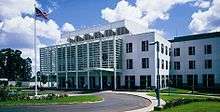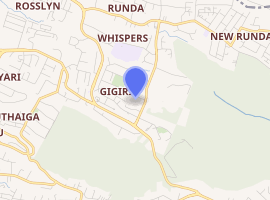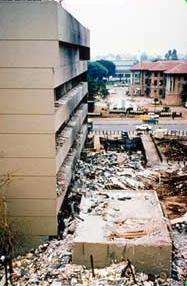Embassy of the United States, Nairobi
The Embassy of the United States of America to Kenya (also known as Embassy Nairobi by the State Department), located in Nairobi, is home to the diplomatic mission of the United States to the Republic of Kenya. The embassy opened in central Nairobi on 2 March 1964, when the United States established diplomatic relations with Kenya. In 1998, the original embassy was the target of a terrorist attack, after which a new embassy building was constructed in Gigiri, a suburb of Nairobi, in 2003.
| Embassy of the United States of America to Kenya | |
|---|---|
 | |

| |
| Location | United Nations Avenue, Nairobi, Kenya |
| Coordinates | 1.233985°S 36.810552°E |
| Ambassador | Kyle McCarter |
| Website | https://ke.usembassy.gov/embassy/nairobi/ |
History

Original embassy
The United States recognized Kenya upon its independence on 12 December 1963. The US formally established diplomatic relations with Kenya on 2 March 1964. The US embassy in Nairobi was established the same day.[1][2] The original embassy (1.289017°S 36.826880°E) was located on the western corner of Moi Avenue and Haile Selassie Avenue in central Nairobi.[3][4]
1998 bombing
On the morning of August 7, 1998, a truck loaded with explosives detonated in a parking lot between the embassy and two commercial, high-rise buildings (both of which contained some offices for US diplomatic staff). The attack killed 213 people and injured approximately 4000. Only 12 of the dead were Americans; most were Kenyans killed when the Ufundi House—a seven-storey office building adjacent to the embassy—collapsed. A simultaneous attack occurred at the US Embassy in Dar es Salaam, Tanzania. The attacks were attributed to al-Qaeda.[5]
In 1999, the federal government convened a group of experts to examine the security of US diplomatic posts worldwide.[6][7]:3–5 The group later released a report, stating that the security of US diplomatic posts (collectively, the US's "overseas presence") were "unacceptable"[7]:5 and that the US overseas presence was "perilously close to the point of system failure."[7]:5 The 1998 embassy bombings and the September 11 terrorist attacks three years later prompted the US State Department to start a multibillion-dollar building and renovation program to make US embassies around the world safer.[5][6][7]
The original embassy grounds were donated to a charitable trust, which turned the property into the August 7th Memorial Park and maintains the grounds. The August 7th Memorial Park contains a garden, a sculpture made of debris from the attack, a wall engraved with the names of victims, and a visitor's center (built on the site of the Ufundi House).[3]
New embassy
In 2003,[5] the US opened a new embassy in the suburb of Gigiri, across from the Office of the United Nations in Nairobi.[8][9] The new embassy building was inaugurated on March 3, 2003[10] and has 402,100 square feet (37,350 m²) of floor space.[11] Several threats shortly after its opening caused some closures in mid-2003[8] and in 2014, some staff from the embassy were relocated due to a possible security threat.[12]
Mission
The embassy is home to the US diplomatic mission to Kenya—diplomats and personnel representing United States interests in the host country, led by the United States Ambassador to Kenya.[lower-alpha 1][2][13] The US diplomatic mission to Kenya is working with the Kenyan government to prevent the spread of HIV/AIDS, promote and strengthen Kenyan institutes of democracy, and promote business between the US and Kenya;[2] besides diplomatic activities, the embassy also provides consular services, such as issuing visas, passports (for US citizens), and providing assistance to US citizens in distress.[14][15][16]
From 2015 to 2018, it was also the base for the US diplomatic mission to Somalia, due to the security situation in Somalia.[17][18]
Notes
- "Embassy" can refer to the diplomatic mission or, in common usage, the building the mission is housed (especially the chancery), while "diplomatic mission" is sometimes used interchangeably with "embassy."[13]
References
- "A Guide to the United States' History of Recognition, Diplomatic, and Consular Relations, by Country, since 1776: Kenya". history.state.gov. Office of the Historian, United States Department of State. Retrieved March 14, 2015.
- "About Us - Embassy of the United States". United States embassy, Nairobi. Archived from the original on March 11, 2015. Retrieved March 13, 2015.
- "The Fateful Day of August 1998 Bombing". August 7th Memorial Park. Archived from the original on April 2, 2015. Retrieved 14 March 2015.
- Google (March 2, 2015). "August 7th Memorial Park / Former US Embassy (1964–1998)" (Map). Google Maps. Google. Retrieved March 2, 2015.
- "U.S. Embassy Nairobi, Kenya". Discover Diplomacy. United States Department of State. Archived from the original on April 2, 2015. Retrieved March 13, 2015.
- "Bureau of Overseas Buildings Operations". AllGov.com. Retrieved March 14, 2015.
ince the 1998 bombings of American embassies in east Africa, the federal government has conducted the largest construction effort in US diplomatic history to upgrade diplomatic posts and secure them against terrorist attacks.
- "America's Overseas Presence in the 21st Century" (PDF). Overseas Presence Advisory Panel. November 1999. Retrieved March 14, 2015.
- "US re-opens Kenyan embassy". BBC News. June 25, 2003. Retrieved March 14, 2015.
- Google (March 2, 2015). "United Nations Ave., Gigiri, Nairobi, Kenya" (Map). Google Maps. Google. Retrieved March 2, 2015.
- "Hideout may hold terror clues". St.Petersburg Times. March 4, 2003. Retrieved March 14, 2015.
- "A Secure but Welcoming Presence in Kenya". HOK. Archived from the original on April 2, 2015. Retrieved March 14, 2015.
- "US to cut Kenya embassy staff as threat of 'sophisticated' attacks grows". The Guardian. Nairobi. AFP. May 17, 2014. Retrieved March 14, 2015.
- "Diplomatic Dictionary". Discover Diplomacy. United States Department of State. Archived from the original on March 18, 2015. Retrieved March 14, 2015.
- "Welcome to American Citizens Services (ACS) Nairobi". Embassy of the United States: Nairobi, Kenya. United States Department of State. Archived from the original on March 7, 2015. Retrieved March 14, 2015.
- "Visas". Embassy of the United States: Nairobi, Kenya. United States Department of State. Archived from the original on March 12, 2015. Retrieved March 14, 2015.
- "What is a U.S. Embassy?". Discover Diplomacy. United States Department of State. Archived from the original on May 10, 2018. Retrieved March 14, 2015.
- Psaki, Jen (February 24, 2015). "White House Nomination of United States Ambassador to Somalia". United States Department of State. Retrieved March 13, 2015.
President Obama, today, nominated Katherine S. Dhanani to serve as the first United States Ambassador to Somalia since 1991...If confirmed, the Ambassador will lead the U.S. Mission to Somalia, currently based at the U.S. Embassy in Nairobi, Kenya. As security conditions permit, we look forward to increasing our diplomatic presence in Somalia and eventually reopening the U.S. Embassy in Mogadishu.
- "A Guide to the United States' History of Recognition, Diplomatic, and Consular Relations, by Country, since 1776: Somalia". history.state.gov. U.S. Department of State, Office of the Historian. Retrieved March 13, 2015.
Through the U.S. Embassy in Nairobi, Kenya, the United States maintained regular dialogue with transitional governments and other key stakeholders in Somalia, and after January 17, 2013, with the newly recognized central government of Somalia.
External links
- Official website

